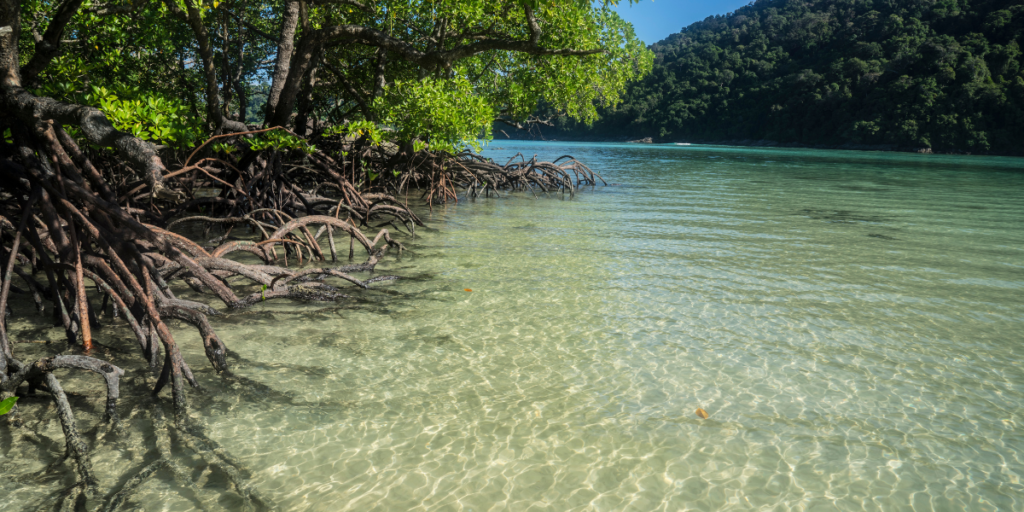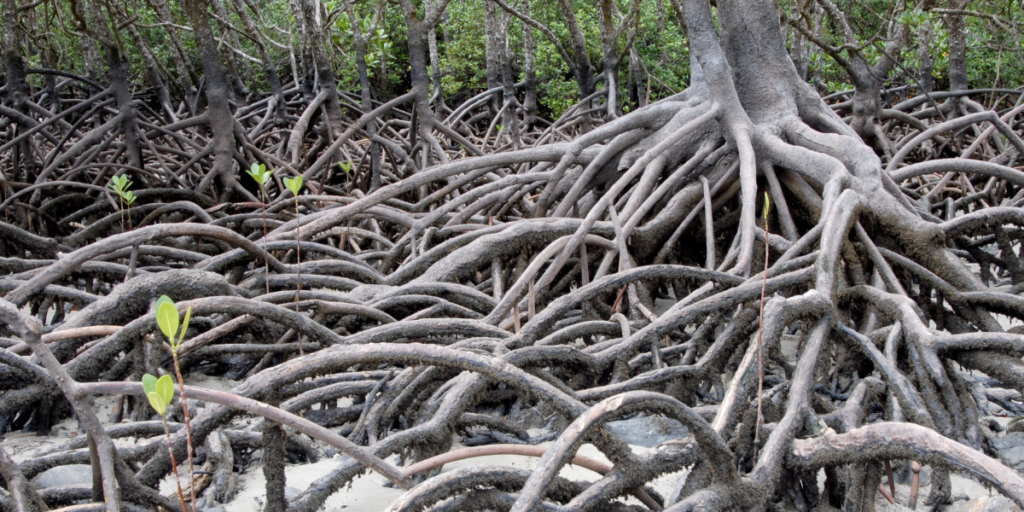Guardians of the Coast: Unraveling the Significance of Mangroves in Shielding Coastal Areas from Storms and Erosion
You stand on the beach, watching as waves crash against the shore. The sound is both soothing and overwhelming, a reminder of nature’s power. But what if there was a way to protect coastal communities from this force?
Enter mangroves – trees that grow in saltwater and are uniquely adapted to withstand harsh coastal conditions. Mangroves have long been valued for their role in storm protection and erosion prevention, making them an important component of coastal ecosystems around the world.
As you look out at the water, it may be hard to picture how these trees can make a difference. After all, they appear small and fragile compared to the vastness of the ocean. But don’t be fooled – mangroves are resilient guardians of coastal communities.
Their complex root systems trap sediment and provide stability to shorelines, reducing erosion caused by waves and currents. In addition, mangrove forests act as natural buffers against storm surges and wind damage by absorbing much of the energy from incoming storms. These functions not only protect human settlements but also serve as critical habitat for marine life that rely on healthy mangrove ecosystems for survival.
Key Takeaways
- Mangroves act as natural buffers against storm surges and wind damage.
- They stabilize shorelines and reduce erosion caused by waves and currents.
- Mangrove biodiversity maintains healthy coastal ecosystems critical to nearby communities.
- Without healthy mangrove forests, coastal areas become more vulnerable to storms and erosion.

Overview of Mangrove Ecosystems
Mangrove ecosystems are a fascinating and vital habitat for countless species, providing crucial shelter, food, and protection from storms and erosion. These ecosystems are found in the intertidal zone of tropical and subtropical coastal regions around the world.
Mangroves have unique adaptations that allow them to survive in these harsh environments, including salt tolerance, aerial roots for gas exchange and support, viviparity (the ability to germinate on the parent tree), and leaf waxes that protect against desiccation.
Mangrove forests also provide important economic benefits to local communities. They serve as nurseries for many commercially important fish species, such as snappers and groupers. Additionally, mangroves act as natural water filtration systems by trapping sediment and pollutants before they reach coral reefs or other sensitive habitats. This helps maintain water quality for human use such as fishing or tourism activities.
Overall, mangrove biodiversity plays a significant role in maintaining healthy coastal ecosystems, which is critical to the resilience of communities living nearby.
Physical Characteristics of Mangroves
You’ll see towering, tangled roots and thick leaves as you walk through the dense forest of these salt-loving plants. Mangroves are unique trees that have adapted to living in harsh coastal environments.
A key feature of mangroves is their root systems, which play an essential role in protecting coastal areas from storms and erosion. Mangrove root systems are highly complex and specialized structures that allow them to thrive in a constantly changing environment.
The aerial prop roots that extend above the water surface provide structural support for the tree, while also trapping sediment and reducing wave energy. In addition to their physical strength, mangrove roots are also able to filter out excess salt, allowing the tree to survive in brackish water.
The intricate network of roots creates a natural barrier against waves and storm surges, reducing the impact on nearby shorelines. As waves crash into the roots, they lose energy and become less powerful by the time they reach land. This process helps prevent erosion along coastlines and reduces damage caused by hurricanes or typhoons.
Understanding how mangroves function is crucial in developing effective strategies for protecting vulnerable coastal communities from natural disasters.
The Role of Mangroves in Storm Protection
As you learn about mangroves, it’s important to understand their role in protecting coastal areas from storms and erosion.
Mangroves are highly effective at dissipating wave energy. They reduce the intensity of incoming waves and prevent damage to shorelines.
Additionally, they help to reduce storm surge by acting as a natural buffer between the ocean and land. This can be crucial during extreme weather events.
Lastly, mangroves play a key role in preventing erosion. They trap sediments with their extensive root systems and stabilize shorelines against the forces of wind and water.
Wave Energy Dissipation
When waves hit a shoreline with healthy mangroves, you’ll notice that the energy of the waves is dissipated and reduced. This is because mangrove forests are excellent at wave attenuation, meaning they absorb and slow down the force of incoming waves.
The intricate root systems of mangroves act as barriers that break up and disperse wave energy, reducing its impact on the coastline.
Coastal engineers have recognized the importance of mangroves in protecting shorelines from erosion caused by storm surges. In fact, many coastal protection projects now incorporate the use of mangrove restoration to reinforce natural defenses against storm damage.
By recognizing and utilizing the power of these ecosystems to dissipate wave energy, we can work towards creating more resilient coastal communities that are better equipped to withstand future storms.
Reduction of Storm Surge
By utilizing the natural power of mangrove forests to reduce storm surges, coastal communities can become more resilient in the face of future storms. Mangroves have been shown to effectively reduce storm surge by acting as a natural barrier against high waves and strong winds. The complex root systems of mangroves help create friction that slows down incoming waves, dissipating their energy and reducing their height before they reach land.
This not only protects coastal areas from flooding but also minimizes erosion caused by the force of the waves. While the benefits of using mangroves for storm surge reduction are clear, there are also some limitations to consider. For example, mangroves require specific environmental conditions to thrive and may not be suitable for all coastal areas. Additionally, while they can provide effective protection against moderate storms, severe storms may still cause significant damage even with the presence of mangrove forests.
Despite these limitations, case studies and examples from around the world have demonstrated that incorporating mangrove forests into coastal protection strategies can be an effective way to mitigate the impacts of storms on vulnerable communities.
Prevention of Erosion
Preventing erosion along coastlines is a crucial aspect of preserving the natural beauty and stability of our beaches. Mangroves play a significant role in controlling erosion by trapping sediments and providing a physical barrier against waves and currents.
Here are some ways that mangroves contribute to coastal stability:
- Root System: The extensive root system of mangroves helps anchor soil, preventing it from being washed away by waves and currents.
- Sediment Trapping: As water flows through mangrove forests, sediments get trapped in the roots and leaves, building up soil levels over time.
- Wave Dissipation: Mangrove roots slow down the speed of incoming waves, reducing their energy as they reach the shore.
Mangroves also serve as habitats for many species of plants and animals, making them an essential component of coastal ecosystems. By protecting these vital ecosystems, we can ensure sustainable development while minimizing damage to coastal areas caused by erosion.
Mangroves offer a natural solution to erosion control along coastlines. Their unique root system helps anchor soil while trapping sediment and dissipating wave energy. By preserving these important ecosystems, we can maintain healthy coastal environments that provide critical habitat for marine life while ensuring long-term coastal stability.
Environmental Threats to Mangrove Ecosystems
You need to understand the devastating effects of human activities on mangrove ecosystems, which are crucial in protecting coastal areas from storms and erosion. Climate change impacts such as rising sea levels and increased frequency of extreme weather events also threaten these vital ecosystems.
Human activities like deforestation, pollution, and overfishing further exacerbate these environmental threats. Deforestation destroys the natural habitat for mangroves, while pollution from oil spills or sewage discharge can harm their growth and reproduction. Overfishing disrupts the food chain and affects the overall health of the ecosystem.
Without healthy mangrove forests, coastal areas become more vulnerable to storms and erosion, as well as losing valuable biodiversity that supports local communities. It’s important to recognize our impact on these ecosystems and take action to protect them for future generations.
Conservation and Restoration Efforts
To effectively conserve and protect mangrove ecosystems, you must prioritize the protection and preservation of existing mangrove forests. This requires proper management strategies to maintain the health and vitality of these valuable habitats.
Restoration and reforestation projects can also play a significant role in restoring degraded areas or establishing new ones where necessary.
Additionally, community engagement and education campaigns can help raise awareness about the importance of mangroves, encouraging local communities to support conservation efforts.

Protection and Preservation of Existing Mangrove Forests
Preserving our mangrove forests is vital for protecting coastal communities from devastating storms and erosion, so let’s work together to ensure their longevity.
These unique ecosystems provide a natural barrier against strong winds and waves, reducing the impact of storms on shorelines. Additionally, mangroves help to stabilize sediments and prevent soil erosion by trapping sediment particles with their intricate root systems.
To protect existing mangrove forests, there are several conservation methods that can be employed. One such method is through sustainable harvesting practices that allow for the extraction of resources without damaging the ecosystem. Another approach involves creating protected areas where human activity is restricted to minimize disturbances that could harm the mangroves.
Furthermore, economic benefits can also incentivize local communities to preserve these vital habitats by promoting ecotourism opportunities or providing livelihoods through sustainable resource management practices.
Overall, preserving our mangrove forests not only protects coastal areas from storms and erosion but also provides numerous ecological and economic benefits. By working together to implement effective conservation methods and raising awareness about the value of these unique ecosystems, we can ensure their longevity for generations to come.
Restoration and Reforestation Projects
Imagine walking along a once-barren coastline, now lush with new growth as mangrove restoration and reforestation projects have brought life back to the area. These initiatives are vital in maintaining the protective function of mangroves against storms and erosion.
In recent years, several organizations have implemented such projects worldwide, recognizing their cost-effectiveness and social benefits. Cost-effectiveness analysis has shown that mangrove restoration is more economical than engineering solutions such as building sea walls or breakwaters. Not only do these natural barriers provide protection from storm surges and waves, but they also offer additional benefits such as carbon sequestration, habitat for marine life, and recreational opportunities.
Furthermore, involving local communities in these efforts not only provides job opportunities but also fosters a sense of ownership and responsibility for preserving their coastal ecosystems. By restoring or replanting mangroves, we can create resilient coastlines that benefit both people and nature for years to come.
Community Engagement and Education Campaigns
Engaging local communities and educating them about the importance of stakeholder engagement in preserving coastal ecosystems is crucial for effective restoration efforts.
Outreach strategies for coastal communities can include a range of activities, such as community meetings, educational workshops, and hands-on conservation projects. These initiatives help to raise awareness about the vital role that mangroves play in protecting shorelines from storms and erosion.
To create a lasting impact, it’s essential to involve stakeholders at all levels of decision-making processes. This means engaging not only local residents but also government officials, NGOs, and businesses that operate in the area.
By working together towards a common goal of ecosystem preservation, we can create more sustainable practices that benefit both humans and nature alike. Ultimately, these efforts can lead to long-term preservation efforts that will keep coastal communities safe for generations to come.
Frequently Asked Questions
How do mangroves benefit aquatic life in addition to protecting coastal areas?
Mangroves provide a habitat for numerous aquatic species, helping to maintain biodiversity and supporting ecological impact. In addition to protecting coastal areas from storm surges and erosion, they play a crucial role in conservation efforts.
What are some of the economic benefits associated with mangrove ecosystems?
You might be surprised to learn that mangrove ecosystems contribute significantly to the economy. Mangrove based livelihoods such as fishing and forestry provide income for local communities, while sustainable tourism brings in revenue through activities like birdwatching and kayaking.
What are the potential dangers of relying solely on mangroves for storm protection?
Relying solely on mangroves for storm protection has limitations. They work best in combination with diverse coastal ecosystems. Technical studies highlight the importance of planning for multiple solutions to protect communities and infrastructure from natural disasters.
How do mangroves differ from other coastal vegetation in their ability to withstand storms and erosion?
Mangrove root systems provide better resistance to erosion and sediment trapping than other coastal vegetation. Their ability to withstand storms is due to their deep root systems that anchor them in place, making them a valuable asset in protecting coastlines.
How do climate change and rising sea levels impact mangrove ecosystems and their ability to protect against storms?
Climate change and rising sea levels threaten mangrove ecosystems, reducing their ability to protect local communities from storms. Mitigation measures include restoring degraded areas, limiting human activities, and promoting sustainable practices.
Conclusion
Congratulations! You’ve just learned about the vital role of mangroves in protecting coastal areas from storms and erosion.
As you now know, mangrove ecosystems are unique and complex, with physical characteristics that make them ideal for storm protection. Did you know that, according to research, mangroves can reduce wave heights by up to 66% and provide a natural barrier against strong winds?
This incredible statistic highlights just how important these ecosystems are in protecting our coastlines from natural disasters. However, despite their critical importance, mangrove ecosystems around the world are facing significant environmental threats, including deforestation and pollution.
It is essential that we prioritize conservation and restoration efforts to preserve these valuable habitats for future generations. By working together to protect these vital ecosystems, we can ensure that they continue to play a crucial role in protecting our shorelines for years to come.




